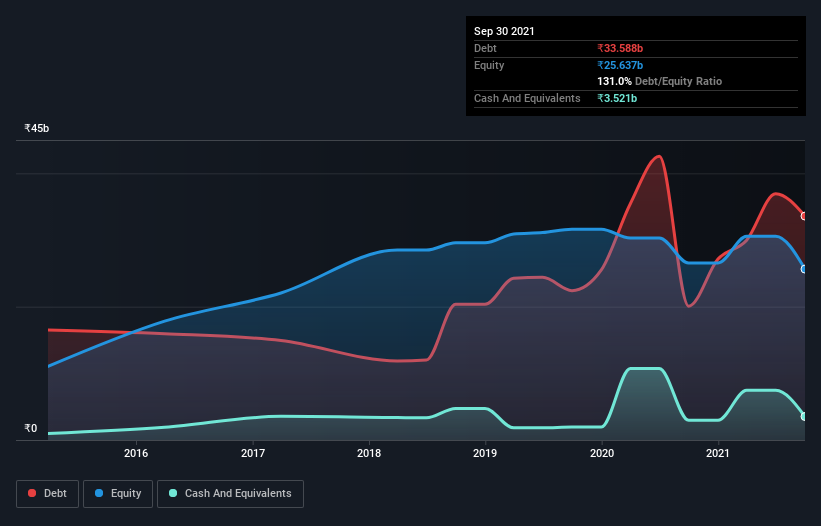
Howard Marks put it nicely when he said that, rather than worrying about share price volatility, 'The possibility of permanent loss is the risk I worry about... and every practical investor I know worries about.' So it seems the smart money knows that debt - which is usually involved in bankruptcies - is a very important factor, when you assess how risky a company is. Importantly, Varroc Engineering Limited (NSE:VARROC) does carry debt. But is this debt a concern to shareholders?
When Is Debt A Problem?
Debt assists a business until the business has trouble paying it off, either with new capital or with free cash flow. Part and parcel of capitalism is the process of 'creative destruction' where failed businesses are mercilessly liquidated by their bankers. While that is not too common, we often do see indebted companies permanently diluting shareholders because lenders force them to raise capital at a distressed price. Of course, plenty of companies use debt to fund growth, without any negative consequences. When we think about a company's use of debt, we first look at cash and debt together.
View our latest analysis for Varroc Engineering
What Is Varroc Engineering's Debt?
You can click the graphic below for the historical numbers, but it shows that as of September 2021 Varroc Engineering had ₹33.6b of debt, an increase on ₹20.1b, over one year. However, because it has a cash reserve of ₹3.52b, its net debt is less, at about ₹30.1b.

How Healthy Is Varroc Engineering's Balance Sheet?
Zooming in on the latest balance sheet data, we can see that Varroc Engineering had liabilities of ₹64.6b due within 12 months and liabilities of ₹21.7b due beyond that. Offsetting these obligations, it had cash of ₹3.52b as well as receivables valued at ₹16.2b due within 12 months. So its liabilities total ₹66.6b more than the combination of its cash and short-term receivables.
Given this deficit is actually higher than the company's market capitalization of ₹47.6b, we think shareholders really should watch Varroc Engineering's debt levels, like a parent watching their child ride a bike for the first time. Hypothetically, extremely heavy dilution would be required if the company were forced to pay down its liabilities by raising capital at the current share price. When analysing debt levels, the balance sheet is the obvious place to start. But ultimately the future profitability of the business will decide if Varroc Engineering can strengthen its balance sheet over time. So if you want to see what the professionals think, you might find this free report on analyst profit forecasts to be interesting.
In the last year Varroc Engineering wasn't profitable at an EBIT level, but managed to grow its revenue by 34%, to ₹131b. With any luck the company will be able to grow its way to profitability.
Caveat Emptor
While we can certainly appreciate Varroc Engineering's revenue growth, its earnings before interest and tax (EBIT) loss is not ideal. Its EBIT loss was a whopping ₹5.6b. Considering that alongside the liabilities mentioned above make us nervous about the company. We'd want to see some strong near-term improvements before getting too interested in the stock. Not least because it burned through ₹5.1b in negative free cash flow over the last year. That means it's on the risky side of things. There's no doubt that we learn most about debt from the balance sheet. But ultimately, every company can contain risks that exist outside of the balance sheet. We've identified 2 warning signs with Varroc Engineering (at least 1 which is significant) , and understanding them should be part of your investment process.
If, after all that, you're more interested in a fast growing company with a rock-solid balance sheet, then check out our list of net cash growth stocks without delay.
New: Manage All Your Stock Portfolios in One Place
We've created the ultimate portfolio companion for stock investors, and it's free.
• Connect an unlimited number of Portfolios and see your total in one currency
• Be alerted to new Warning Signs or Risks via email or mobile
• Track the Fair Value of your stocks
This article by Simply Wall St is general in nature. We provide commentary based on historical data and analyst forecasts only using an unbiased methodology and our articles are not intended to be financial advice. It does not constitute a recommendation to buy or sell any stock, and does not take account of your objectives, or your financial situation. We aim to bring you long-term focused analysis driven by fundamental data. Note that our analysis may not factor in the latest price-sensitive company announcements or qualitative material. Simply Wall St has no position in any stocks mentioned.
Have feedback on this article? Concerned about the content? Get in touch with us directly. Alternatively, email editorial-team (at) simplywallst.com.
About NSEI:VARROC
Varroc Engineering
Designs, manufactures, and supplies exterior lighting systems, plastic and polymer components, electrical and electronics components, advanced safety systems, and precision metallic components worldwide.
High growth potential and fair value.
Market Insights
Community Narratives



